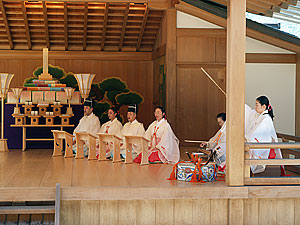
By Bill Roberts
A soft crimson leaf.
Floating in the autumn sun
This spiritual gem
I had several close encounters with Mme. Kurenai Deguchi, the Spiritual Leader, during my visit to Oomoto in 2002, opportunities to glimpse her various facets.
I heard her beautiful voice when she led the Oomoto faithful in prayer. I saw her receive the love and respect of her followers. I felt her confidence when she welcomed two inter-faith gatherings. I had tea with her twice, experiencing her gracious and artistic manner. I even saw her playful side when I danced with her. More about dancing later.
Like a precious gem, Mme. Deguchi has many polished facets. Less than 18 months into her life as Fifth Spiritual Leader, she appears to possess the energy, artistry and humanity to lead Oomoto into the new century.
Now 46, she became Spiritual Leader after the death of Mme. Kiyoko Deguchi, the Fourth Spiritual Leader, on April 29, 2001. The Fifth Spiritual Leader was born Kurenai Hirose, a niece of Kiyoko Deguchi. After Kiyoko chose Kurenai (which means crimson) to succeed her, she took the customary step of adopting her. Kurenai Hirose, who has never been married, became Kurenai Deguchi.
Under Oomoto doctrine, the Spiritual Leader must be a woman and a descendant of Founder Nao Deguchi. Kurenai is a great-great granddaughter of the Founder. Kiyoko Deguchi publicly announced Kurenai as her successor just one week before she died somewhat unexpectedly at age 66 following a brief illness. It would appear from the outside, at least, that Kurenai Deguchi, a pharmacist by profession and tea teacher by passion, was thrust overnight into her spiritual mission.
The Spiritual Leader is extremely busy so I was pleasantly shocked when I was told upon arrival in late October this year that she wanted to see me two days later.
We met in a tea room in a secluded garden called Taian-kyo, which means “Dwelling of Great Peace,” at Oomoto’s Kameoka headquarters. I was cold and still jet-lagged as I trekked up the hill with my interpreter and a photographer to Taian-kyo. The autumn colors were just beginning to show, leaves glistening in a drizzle. Mme. Deguchi was waiting for us in the tea room.
We made deep formal bows. I sat next to her and we began to speak through my interpreter. One of her assistants prepared tea while another brought the tea sweet. I quickly warmed up and felt at home. The jet lag, however, didn’t go away.
The first thing Mme. Deguchi did was to thank me for editing the English versions of the speeches she and others would give at the inter-faith meetings beginning in two days. I told her what I tell all Oomoto followers when they thank me: I get more out of helping them than they do.
I began to tell her about myself, and my background in ceramics, which is what brought me to Oomoto the first time, in 1999. It was evident that Mme. Deguchi knew all about me. In preparation for my visit she apparently had watched a video of a speech I had given at Oomoto in early April 2001.
I told her of my plan to write a book about Oomoto. She said it was a good idea because it has been thirty years since Frederick Franck wrote “An Encounter With Oomoto,” which explained the organization to English speakers and generated interest among Western artists.
She then told me about the place we were meeting, “The Tea Room of the Washing Moon,” just one of many tea rooms in Taian-kyo. On a clear night when the moon is full, you can slide open one of the screens and see the moon’s reflection in the brook alongside the tea house. Mme. Deguchi opened a screen to show me. It was mid-morning, and the sun was now piercing the clouds.
When I had been there about thirty minutes she apologized for having to leave for another appointment. We were invited to remain. She rose and, with the elegance of the Noh dancer that she is, floated from the room. We stayed ten minutes finishing coffee, which had been brought after the tea. Then we trekked out of the garden and down the hill. I did not know I would soon return.
Two days later, Mme. Deguchi opened the Second Prayer Offering and World Religious Forum in Kyoto with welcoming remarks that focused on the need for education to combat violence. The next day she opened the 4th Asian Delegates Conference of Jinrui Aizenkai (Universal Love and Brotherhood Association) with similarly impassioned words.
Although her active participation was limited to the welcoming addresses she sat through the speeches and we felt her presence. On both afternoons I noticed her having as much trouble staying awake in the stuffy room as the rest of us.
The following day was the Autumn Grand Festival in Ayabe. Mme. Deguchi was on center stage. I attended last year’s autumn festival, which was Mme. Deguchi’s first as Spiritual Leader. This year her voice seemed stronger as it rang through the worship hall. Trained for Noh chanting, her voice is rich and full with an operatic feeling.
The day after the festival I was told I had been invited to Mme. Deguchi’s tea room again, this time to accompany Rabbi Ron Kronish and his wife who were visiting from Israel for the inter-faith activities.
It was another drizzly day when we climbed to Taian-kyo. The Spiritual Leader was not in the tea room when we entered. When she entered with tea utensils in hand, I knew she was going to honor us by making the tea herself.
I know only a little about tea but enough to recognize that this woman is an accomplished artist of the tea ceremony, which to Oomoto followers is a spiritual practice. Before Mme. Deguchi became Spiritual Leader, as I understand, she was a popular and gifted tea teacher. Since becoming Spiritual Leader she has been unable to continue teaching.
Her movements to rinse the bowl, scoop the powder, dip the hot water and mix the rich green tea were as graceful as a soft leaf on a gentle autumn wind. She prepared a bowl for the rabbi, one for his wife and one for me. Then she slid over to sit next to the rabbi while an assistant made tea for the others present.
Mme. Deguchi and Rabbi Kronish did most of the talking. I had already had my highlight of the morning—drinking tea prepared by the Spiritual Leader.
About a week later I attended the Utamatsuri, a traditional poetry festival, and a Sunday service in celebration of the 50th anniversary of Oomoto’s Tokushima branch on the island of Shikoku. The Spiritual Leader watched the Saturday night poetry festival, which she had helped to judge. On Sunday, she presided at the religious service and then watched enthusiastically as Oomoto members performed Noh dances.
I had been asked to give a brief speech during lunch. We made eye contact several times while I spoke and it seemed to me that she understood my words before they were translated. I left wondering if she knows more English than she lets on.
The Tokushima event ended on a most unreligious and raucous note. A group of professional folk dancers in traditional costume performed a local dance called “awa odori.” The twisting, gyrating and wiggling is a lot like the rock ‘n’ roll dancing of my youth.
After the professionals had made a complete circuit of the grounds doing this dance under a hot afternoon sun, many of the Oomoto followers joined them. It should be pointed out that many, though not all, had been drinking liberal amounts of sake after lunch.
Things reached a fever pitch as more people joined the dance. I was shooting pictures as fast as I could. Suddenly, Mme. Deguchi stepped out of the shrine and into the crowd. She had changed from kimono into modern dress. She was waving her hands in the air, clapping, and shaking. To the glee of those gathered she immediately joined the dance.
Soon enough she made eye contact with me as I was shooting pictures of her. She gestured and said something in Japanese, which must have been “join us.” Before I knew it she had me out there with her. And Mme. Deguchi kept looking back over her shoulder to make sure I was still there. I haven’t danced like that since the last time I went to a Rolling Stones concert.
The dance ended and the Spiritual Leader was ready to leave. The followers bowed to her repeatedly and she to them. They had been thrilled by her presence all weekend, capped off by the dance.
I wondered if the Spiritual Leader knows this old proverb from India: God respects me when I pray but he loves me when I sing and dance.
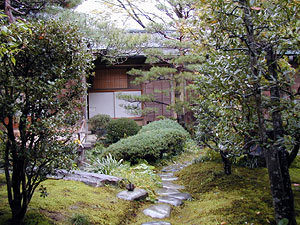 The Tea Room of the Washing Moon in Taian-kyo.
The Tea Room of the Washing Moon in Taian-kyo.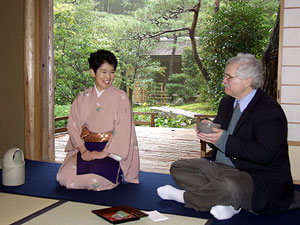 The Spiritual Leader meets the writer.
The Spiritual Leader meets the writer.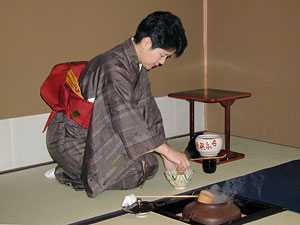 The Spiritual Leader prepares tea.
The Spiritual Leader prepares tea.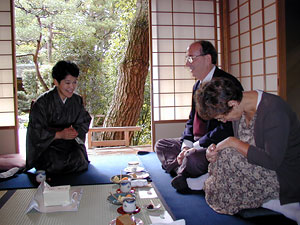 Mme. Deguchi exchanges views with Rabbi Ron Kronish and his wife, Amy.
Mme. Deguchi exchanges views with Rabbi Ron Kronish and his wife, Amy.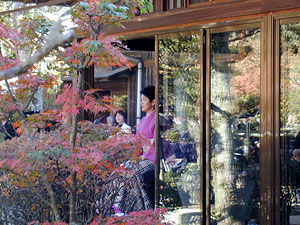 The Spiritual Leader watches a Noh performance in Tokushima.
The Spiritual Leader watches a Noh performance in Tokushima. Noh dancer on the outdoor stage at Tokushima.
Noh dancer on the outdoor stage at Tokushima.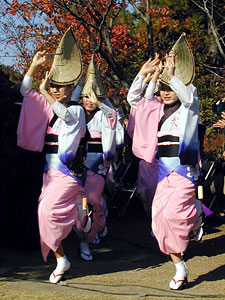
Dance troupe doing the Awa Odori in Tokushima.
 Mme. Deguchi joins members of the Tokushima branch in a raucus dance called the Awa Odori.
Mme. Deguchi joins members of the Tokushima branch in a raucus dance called the Awa Odori.New Contents Thu, May 20, 2010
- Oomoto participates in Sant’Egidio conference : Dialogue among religions and cultures : On divided island nation of Cyprus By Bill Roberts
- Photo Album : Portraits of three branches: Shoko, Tanegashima and Aomori By Bill Roberts
- Oomoto FAQ
- A Letter from Oomoto : Of mountains and myths By Bill Roberts
- Polyglot poem festival The Utamasturi is going international — what’s next? By Bill Roberts
- Ethics education program captures the spirit of Bankyo Dokon By Bill Roberts
- A Letter from Oomoto : A year’s worth of adventure in a summer of branch visits By Bill Roberts
- In Kumamoto, it’s all about water – and fire By Bill Roberts
- A speech by Nevada Taylor at the Kii Branch in Wakayama Prefecture on April 13, 2008.:An Encounter With Oomoto Through Aikido
- Utamatsuri, Poem Festival, in Tokyo(on April 17, 2008)
- A speech by Neil Ryan Walsh at the Kobe branch on Mar. 9th, 2008.:Planting the Seeds of the Soul
- Meeting with the Fifth Spiritual Leader of Oomoto, Madame Kurenai Deguchi by Neil Ryan Walsh
- A speech by Neil Ryan Walsh at the Nagoya branch on Feb. 17th, 2008.:The Japanese Arts beyond National Boundaries
- To the Oomoto branch in Nagoya: City of Eel and Toyota by Neil Ryan Walsh
- A Speech by Nissim Ben Shitrit, Ambassador of Israel on the occasion of the Oomoto Setsubun Grand Festival in Ayabe February 3rd, 2008 : Japan and Israel : Two Lands Balancing the Needs of Traditional Culture and Modern Life. r
- A permanent memorial to Onisaburo (A Speech at the Autumn Grand Festival , November 6, 2007 : )By James Parks Morton, Founder and Chair, Emeritus of The Interfaith Center of New York
- Israel, Palestine and the Power of Poetry(Oomoto believes small efforts can have lasting ripple effects on people and peace)By Bill Roberts
- “Something Great”(This genetics pioneer, a friend of Oomoto, offers a clue to the mystery of life)By Bill Roberts
- Kamishima Cleanup (Harima branch members regularly visit this sacred island to keep the shrine tidy)By Bill Roberts
- Kyotaro Deguchi was one of six recipients of the 2007 James Parks Morton Interfaith Award
What is Oomoto?
- What is Oomoto?
- Spirtual Centers
- Founders and Spiritual Leaders
- History
- Organization and activities
- Teachings and scriptures
- Art Works of Founders and Leaders
Opinions[Archive]
- Statement of regret for the outbreak of war against Iraq (March 20,2003)
- Jinrui Aizenkai dispatched the "Urgent Appeal for a World (Global) Crisis" on March 14.
Grappling with Bioethics[Archive]
- Oomoto’s support for abolishing the death penalty (12, June 2003)
- The Oomoto Foundation protests any birth of a human clone baby. (5, January 2003)
- OOMOTO'S VIEW REGARDING JAPAN’S PERMITION TO THE RESERCH OF HUMAN EMBRYONIC STEM CELLS (ES cells)(12, June 2000)
Vistor’s Review[Archive]
- A speech by Bill Roberts at the Oomoto branch in Hiroshima after its monthly service on March 18, 2007:Encounters with war and peace
- How Bankyo Dokon changed one life by Linda Macphee
- A speech by Bill Roberts at the Hokuriku (Kanazawa) branch on Dec. 3, 2006:Ritual and myth -an encounter with ‘divine madness’
- A speech by Bill Roberts at the Himeji Cultural Center on Feb. 25, 2007:Mesmerized by the Japanese Arts
- A speech by Bill Roberts at the Kobe branch on Feb. 11th, 2007.:There are just human tears and human joy
- A Speech on the occasion of the Oomoto Setsubun Grand Festival in Ayabe February 3rd, 2007 : Egypt's role in Middle East peace
- Keynote Speech for the 28th World Federation Japanese Religionists Conference for World Peace in Tokyo (at Kokugakuin University, Novermber 29, 2006):Vision for Peace in the Middle East By Dr. Munther S. Dajani, Professor Dean, Faculty of Arts, Al Quds University, Jerusalem
- A speech to the Kyoto branch:Spiritual adventures in researching Oomoto leaders
- A Speech at The Oomoto Foundation on Monday, November 6, 2006 : Jordan's role in Middle East By Samir Nouri, Ambassador of the Hashemite Kingdom of Jordan
- A letter from Oomoto:The Young People of Tottori
- A speech by Bill Roberts on the occasion of the dedication ceremony for the new shrine of Tottori Branch By Bill Roberts Oct. 8, 2006
- A speech by Bill Roberts at the Oomoto branch in Hiroshima after its monthly service on March 18, 2007:Encounters with war and peace
- How Bankyo Dokon changed one life by Linda Macphee
- A speech at Setsubun : A Portrait of Oomoto By Bill Roberts Feb. 3, 2006
- New Publication ! By Bill Roberts Feb. 3, 2006 A Portrait of Oomoto
you can read this book in html => http://www.jinruiaizenkai.jp/English/en-kolumno/en-bill/en-sugao/billbook1en.html
E-mail below to order brobert1@ix.netcom.com
Current Topics
- Prayer Offering and World Religious Forum II
- Living the art of dialogue
- Kyotaro Deguchi was one of six recipients of the 2007 James Parks Morton Interfaith Award
Books
Online Books
- Divine Signposts by Onisaburo DEGUCHI
- The Creation of Meaning by Hidemaru Deguchi
- Bankyo Dokon(Seventy years of Inter-Religious Activity at Oomoto)
- Nao Deguchi — A Biography of the Foundress of Oomoto
- The Great Onisaburo Deguchi published by Aiki News
- Bankyo Dokon Seventy Years of Inter-Religious Activity at Oomoto
- Insearch of Meaning
- Nao Deguchi A Biography of the Foundress of Oomoto
- A Portrait of Oomoto By Bill Roberts
Oomoto international Archive
- The History of Oomoto (Jan.– Mar. 1980 — Apr.– Jun. 1982)
- The Ancestors; Friends or Foes? (Apr.– Jun. 1987)
- Tsukinamisai; The Sabbath of Shinto (Jan.– Jun. 1983)
- The Poem Festival at Oomoto; An Ancient Rite Lives Again (Oct.– Dec. 1981)
- Purification of the Universe ; Oomoto's Setsubun Festival (Apr.– Jun. 1981)
Links
Flowers at Ten'on-kyo & Baisho-en (photographs)
Contact
All rights reserved : the Oomoto Foundation Produced by the Netinformational Commission
Since : Mar. 7.1998 Last Update : Thu, May 20, 2010
E-mail : webmaster@oomoto.or.jp
Top Page Nihongo Esperanto Português Roomazi



